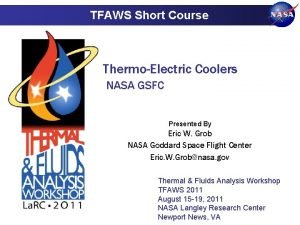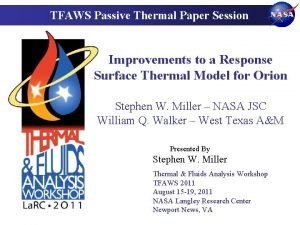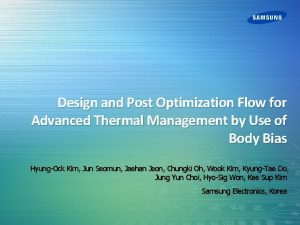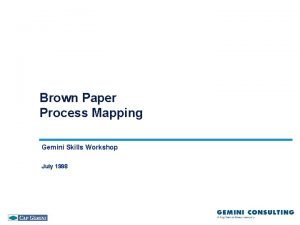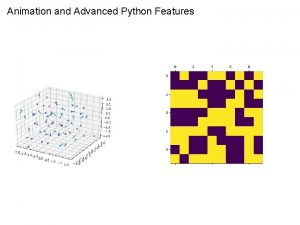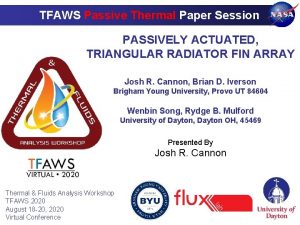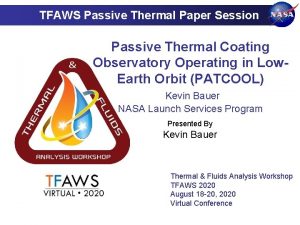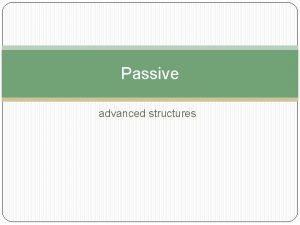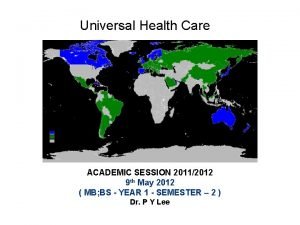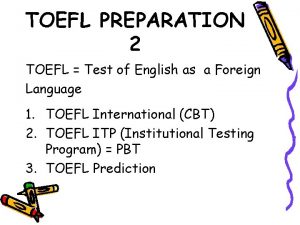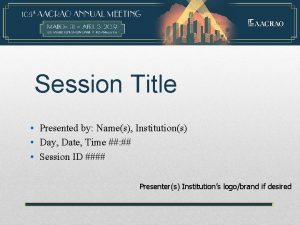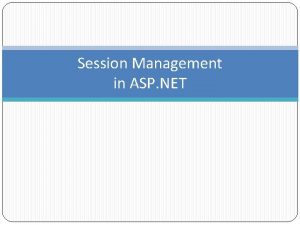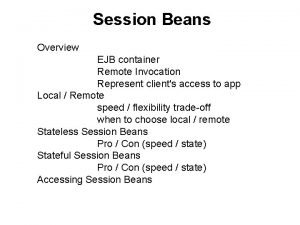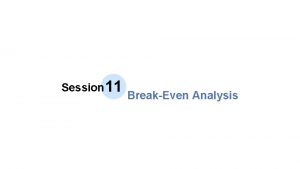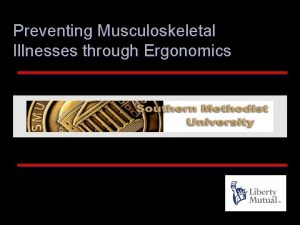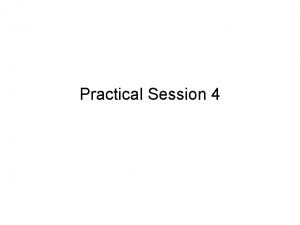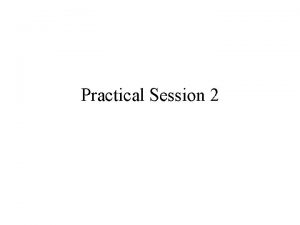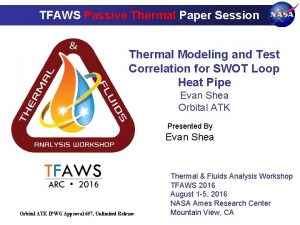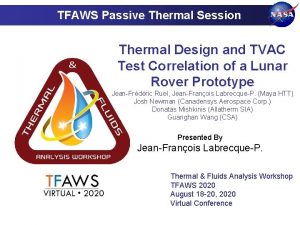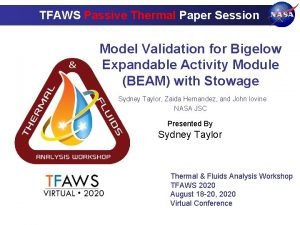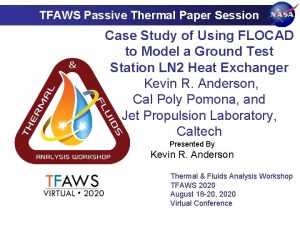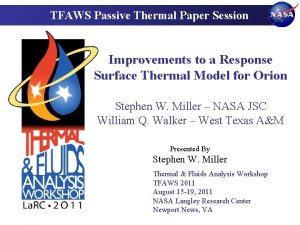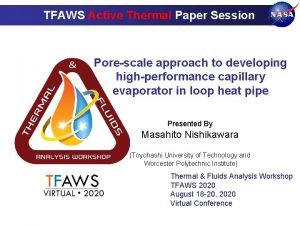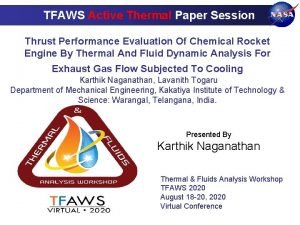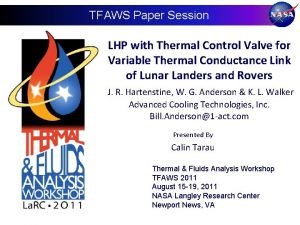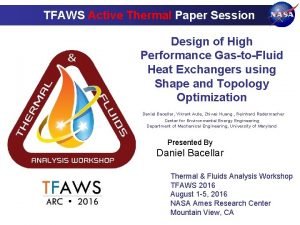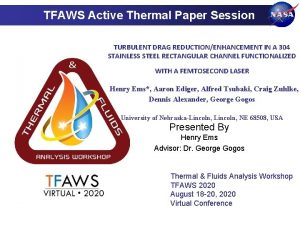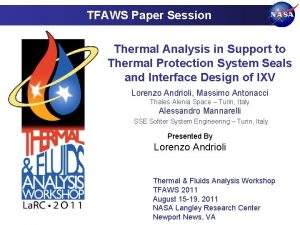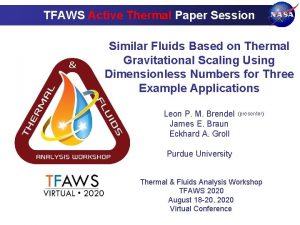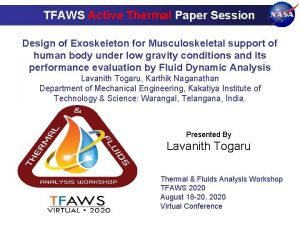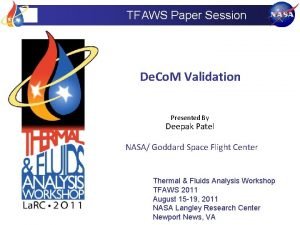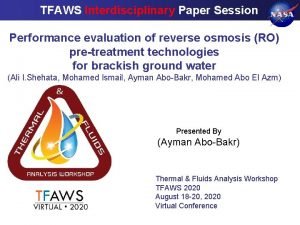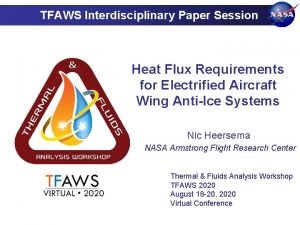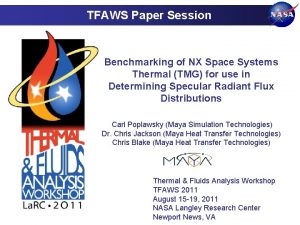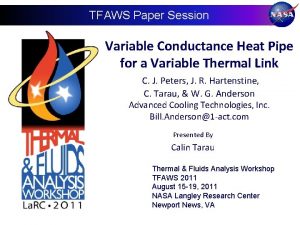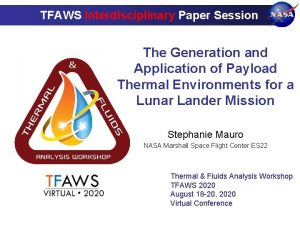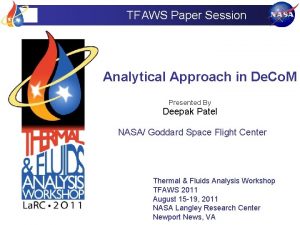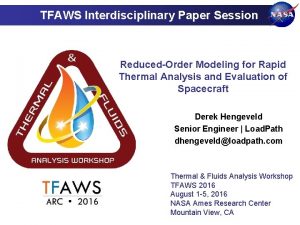TFAWS Passive Thermal Paper Session Advanced Features of






























- Slides: 30

TFAWS Passive Thermal Paper Session Advanced Features of Thermal Desktop/SINDA-FLUINT: I. Interface with Matlab Xiao-Yen Wang II. Using Space. Claim for Complex Geometries William Fabanich Presented By Xiao-Yen Wang & William Fabanich Thermal & Fluids Analysis Workshop TFAWS 2016 August 1 -5, 2016 NASA Ames Research Center Mountain View, CA

Contents • Advanced features of Thermal Desktop/SINDA-FLUINT – – Thermal Desktop® (TD) interface with Matlab SINDA-FLUINT interface with Matlab Provides great flexibility in using the functionality of Matlab Use Space. Claim/TD Direct to incorporate complex geometries into TD. • Demonstration of these advanced features – Lunar Dust thermal model • TD interface with Matlab – Advanced Stirling Radioisotope Generator (ASRG) thermal power model • SINDA-FLUINT interface with Matlab – ASRG thermal power model with Space. Claim/TD Direct 9/10/2021 TFAWS 2016 – August 1 -5, 2016 2

Interface with Matlab Part I: TD and SINDA-FLUINT interface with Matlab Xiao-Yen Wang NASA Glenn Research Center 9/10/2021 TFAWS 2016 – August 1 -5, 2016 3

Lunar Dust Project • Lunar Dust Project: – On the Moon, dust can significantly change the optical properties of coating materials (Reference: NASA TM 2008 -215492, James Gaier, etc) • For AZ-93, dust lowered emissivity by as much as 16% • For Ag/FEP, dust raised emissivity by as much as 11%. – Tests were performed to determine the optical properties of AZ 93 and Ag/FEP coatings (i. e. , emissivity ɛ and solar absorptivity α) under different conditions: • Heating (with a solar simulator) and cooling (in a 30 K coldbox) • The sample disc surface can be pristine, clean, or sub-monolayer dust covered – The time history of temperature of the center of the sample disc was recorded for the length of 500 s to 10, 000 s. – Test data is labeled as “cooling curve” and “heating curve” for cooling and heating test conditions (a series of Excel spreadsheets). 9/10/2021 TFAWS 2016 – August 1 -5, 2016 4

Lunar Dust Test Rig Reference: NASA TM 2008 -215492, James Gaier, etc Test Rig Sample of dusted disk Photomicrographs AZ-93 9/10/2021 Ag/FEP TFAWS 2016 – August 1 -5, 2016 5

Lunar Dust Thermal Model • Thermal Model for the Lunar Dust Project – Objective was to determine the optical properties of clean and dusted sample discs. • A thermal model of the sample disc in the test rig was built using TD. • Disc temperatures were calculated with TD for assumed values of ɛ and α. Ag/FEP Lunar Dust TD thermal model originally built by John Siamidis at GRC 9/10/2021 AZ-93 Sample disc inside an enclosure TFAWS 2016 – August 1 -5, 2016 6

Lunar Dust Thermal Model – Since the TD model results need to match the test data, an iterative method of varying ɛ and α was used to determine the actual values of ɛ and α. – The differences between model results and test data are defined as: err 1 and err 2 < 5. 0 e-4 is considered the solution is converged. – Matlab was programed to perform these iteration procedures automatically ( read in the Excel sheets, find err 1 and err 2, update ɛ and α). – This feature saved time and the user’s effort of manually inputting the optical property values. – This feature allowed hundreds of cases to be run in a short time with eliminated input errors. 9/10/2021 TFAWS 2016 – August 1 -5, 2016 7

Steps need to be performed • For each case, three steps need to be followed: • Step 1: Use Cooling curve to compute ɛ of AZ-93 and Ag/FEP. – Users need to give initial values of ɛ for AZ-93 and Ag/FEP. – Two variables • Step 2: Use Pristine Heating curve to compute lamp power and α of Ag/FEP. – First, define a constant α of Ag/FEP, solve power lamp by checking err 1 (AZ-93 curve). – Then With the correct lamp power, solve α of Ag/FEP by checking err 2 (Ag/FEP curve). Users also need to define the correct ɛ obtained in Step 1. – Two variables • Step 3: Use Heating curve for "Dust, " "Clean, " or "Clean 2" to compute α of AZ-93 and Ag/FEP by checking err 1 and err 2. Users also need to define the correct ɛ obtained in Step 1 and lamp power obtained in Step 2. – Two variables • Note that within each step, the iteration procedure will be performed. 9/10/2021 TFAWS 2016 – August 1 -5, 2016 8

ITERATION PROCEDURE IN MATLAB 1) Give initial values of ɛ and/or α of AZ-93 and Ag/FEP 2) Call TD model to run and get the data of TAZ-93 and TAg/FEP No < 5. 0 E-4 Yes 3) Then compute err 1 and err 2 (difference between model results and test data) 4)Then output the actual values of ɛ and/or α 5) Check convergence criteria (err 1 and err 2 < 5. 0 E-4 ) 9/10/2021 4)Then update ɛ and/or α of AZ-93 and Ag/FEP TFAWS 2016 – August 1 -5, 2016 9 9

Lunar Dust Thermal Model Pristine, Heating case Dust, Heating case Pristine, cooling case Dust, cooling case 9/10/2021 10 TFAWS 2016 – August 1 -5, 2016

Lunar Dust Thermal Model Raw Data Sample Case AZ-93 Ag/FEP Condition Pristine 1022 1 1008 Al. FEP Dusted Cleaned Pristine 1026 2 -1 1009 Al. FEP Dusted Cleaned Pristine 1026 2 1009 Al. FEP Dusted Cleaned Pristine 1027 3 -1 1010 Al. FEP Dusted Cleaned Pristine 1027 3 1010 Al. FEP Dusted Cleaned Emissivity AZ-93 Ag/FEP 0. 750 0. 602 0. 719 0. 770 0. 803 0. 746 0. 738 0. 751 0. 810 0. 778 0. 827 0. 777 0. 722 0. 765 0. 791 0. 783 0. 803 Lamp Power alpha LTF AZ-93 Ag/FEP Factor Watts Analyst Checker 0. 147 0. 1565 1 17960 Harpster Guzik 0. 325 0. 303 1 17960 Harpster Guzik 0. 220 0. 344 1 17960 Harpster Guzik 0. 143 0. 157 1 18330 Harpster Guzik 0. 453 0. 318 1 18330 Harpster Guzik 0. 404 0. 335 1 18330 Harpster Guzik 0. 143 0. 157 1 18330 Harpster Guzik 0. 453 0. 318 1 18330 Harpster Guzik 0. 409 0. 339 0. 99 18147 Harpster Guzik 0. 143 0. 161 1 17115 Harpster Guzik 0. 425 0. 513 1 17115 Harpster Guzik 0. 324 0. 535 1 17115 Harpster Guzik 0. 143 0. 161 1 17115 Harpster Guzik 0. 428 0. 516 0. 99 16997 Harpster Guzik 0. 331 0. 546 0. 98 16761 Harpster Guzik An example of results summary sheet: • For each case: 4 x 3 + 1 = 13 variables need to be determined. • We have hundreds cases. 9/10/2021 TFAWS 2016 – August 1 -5, 2016 11

Advanced Stirling Radioisotope Generator • ASRG was developed as a high efficiency (28%-32%) thermal electric power system for multi mission applications • ASRG can reduce the required amount of Pu-238 by a factor of 4 as compared to radioisotope thermoelectric generators (RTG) Pressure Relief ASC (2) GPHS (2) GMV (1) PRD (1) Housing (1) Device (PRD) Gas Management Valve (GMV) Heat Source Support Analog Telemetry to SC Thermal Insulation AC Power Piston Position Telemetry Shunt Power Advanced Stirling convertor(ASC) Shunt Dissipator Unit General purpose heat source (GPHS) Overview of ASRG components 9/10/2021 TFAWS 2016 – August 1 -5, 2016 12

ASRG thermal power model • Matlab was used to integrate the 3 D ASRG thermal model in TD/SINDA-FLUINT, ASC model in Sage, and control strategy of ASC. – ASRG Thermal model in TD/SINDA-FLUINT • Finite Element/Finite Difference Mesh for the geometries – Heat source, insulation blocks, the housing • Radiation/conduction/convection heat transfer and orbital heating – The ASC is a black box in TD/SINDA-FLUINT, but modeled with the SAGE code, which determines the temperatures and heat flux values throughout the ASC. – ASC control strategy: • Fix the Th (hot end temperature of ASC) • Fix the Ap (piston amplitude of ASC) • Iterations were performed within Matlab to achieve thermal energy balance between ASRG thermal model and ASC. 9/10/2021 TFAWS 2016 – August 1 -5, 2016 13

Iterative procedure implemented with Matlab 1) Choose ASC control strategy. Give initial values of R 6_hot and Qrej 2) Run the SINDA-FLUINT model to compute Th , Tc , and Qin No < 1 E-4 Yes 7) Run SAGE model to compute 3) Use obtained Th , Tc , and power output at alternator Qin to update the R 6_hot and Qrej by running SAGE model 5) Check convergence criteria (difference < 1 E-4) 4) Calculate the difference of R 6_hot and Qrej between two iterations 9/10/2021 TFAWS 2016 – August 1 -5, 2016 14 14

ASRG Thermal Power Model Results 317 K 293 K forced convection case 9/10/2021 ASRG thermal image 15

Space. Claim/TD direct Part II: Space. Claim/TD-Direct Application William Fabanich NASA Glenn Research Center 9/10/2021 TFAWS 2016 – August 1 -5, 2016 16

ASRG Thermal Power Model • Challenge - ASRG program requirements: – Power prediction => System Level Model – But…also want to track heat flow around GPHS and Stirling engine => High Fidelity Model. • Challenge – Thermal analyst needs to: – Build model that can be run as a system model • Easily run many cases – different environments/operating parameters/etc. – Therefore, need to limit model complexity. – Maintain level of fidelity to meet researchers needs. • Can be difficult with TD primitives. • Solution…Space. Claim/TD-Direct 9/10/2021 TFAWS 2016 – August 1 -5, 2016 17

ASRG Thermal Power Model • Space. Claim/TD-Direct – Importing common CAD formats. – Repair and defeaturing/simplification of the geometries. – Generating FE meshes that maintain the needed geometric fidelity. – Creating assemblies that can be re-imported as multiple instances in a TD model. • Example: ASRG Insulation Block – Maintaining a high fidelity geometry of the insulation block around the general purpose heat source (GPHS) was required to characterize the heat loss paths. – The TD model of the ASRG with a finite element mesh generated by Space. Claim provided an accurate (compared to EU test data) estimate of heat loss through the insulation. 9/10/2021 TFAWS 2016 – August 1 -5, 2016 18

ASRG Thermal Power Model • Interest in a highly detailed model of the internal heat flows necessitated use of Space. Claim/TD Direct to create FE components from the original CAD. – TD does has a FE native mesher…but…doesn’t have extended features of TD Direct. • At first – ASRG insulation block done with native mesher… – – – Difficult import – each piece individually. Original CAD poor quality – (not obvious/hard to repair). Contactor to/from area nightmare – had to create 76 Auto. Cad Groups. Mesh hard to control. Making a geometry change = starting over. 9/10/2021 TFAWS 2016 – August 1 -5, 2016 19

ASRG Thermal Power Model • ASRG Insulation Block CAD – Done in Pro. E. – Two Versions: • EU (Engineering Unit) • Flight Unit • EU Insulation – Original CAD - “issues” that Space Claim made easy to fix. • Flight Insulation – Space. Claim/TD Direct made it easy to update ASRG TD model from EU to Flight insulation. 9/10/2021 TFAWS 2016 – August 1 -5, 2016 20

• EU Insulation – Meshed w/ native Mesher. – 8 pieces per end (5 unique) 9/10/2021 TFAWS 2016 – August 1 -5, 2016 21

ASRG Thermal Power Model • ASRG Flight Insulation: – Overall dimensions the same – some difference from EU. – Same number of pieces – but some interfaces are different. – Space. Claim/TD Direct – quick/easy to add thermal and meshing tags – take advantage of existing contactors and RAGs in existing ASRG TD model. – Pieces had directional thermal conductivity – applied material orienter tags. – Two instances of insulation in ASRG model – only need to do work once. 9/10/2021 TFAWS 2016 – August 1 -5, 2016 22

ASRG Thermal Power Model • Special Case – “Engine Out” Scenario – All GPHS heat ends up going through insulation – GPHS at risk of melting. – Insulation “shrinks” – increased thermal conductivity allows increased heat flow to housing. • Investigate effect this has on remaining Stirling performance. – Need to change: • Insulation Block geometry on one side of ASRG model to match shrunken insulation. • Change thermophysical properties for shrunken insulation. 9/10/2021 TFAWS 2016 – August 1 -5, 2016 23

ASRG Thermal Power Model • Before: • After: 9/10/2021 TFAWS 2016 – August 1 -5, 2016 24

ASRG Thermal Power Model Flight Insulation – Midsection View (l): Normal Operation; (r) Post Heat-Dump/Shrunk 9/10/2021 TFAWS 2016 – August 1 -5, 2016 25

ASRG Thermal Power Model 9/10/2021 TFAWS 2016 – August 1 -5, 2016 26

ASRG Thermal Power Model • These geometries were originally (pre- Space. Claim/TD Direct) modeled with FD primitives (CSAF, heat collector) and TD Mesher (insulation). 9/10/2021 TFAWS 2016 – August 1 -5, 2016 27

Space. Claim/TD Direct Summary • Space. Claim/TD Direct advantages: – Gains in speed/ease of import and preparation of geometry. – Tools for import, repair, defeaturing/simplification, and FE meshing. – Ability to update meshes without losing and then having to redefine network elements (e. g. heat loads, contactors). – In some cases, provide more accurate results. • Maintain high geometric fidelity. – Easier to maintain high geometric fidelity while maintaining control over total node/element count. – Also good for easy generation of complex geometries from scratch. • As always…up to analyst to make choices. – Understand limits of tools. – Understand needs of analysis. • Hope to hear about other TD users using this tool – and share their experience and knowledge. 9/10/2021 TFAWS 2016 – August 1 -5, 2016 28

Summary • Advanced features of Thermal Desktop (w. Space. Claim/TD Direct) and SINDA-FLUINT have been applied to challenging thermal modeling. • TD/SINDA-FLUINT can interface with Matlab, allowing users to use functionality of Matlab with them. It becomes a very powerful tool for solving complex problems, saves time and reduce errors. • SINDA-FLUINT allows user to control many parameters in the model, which makes SINDA-FLUINT unique and powerful. • Space. Claim fills the gap for TD to use FEM for complex geometries. TD/SINDA-FLUINT can model primitive and complicated geometries. 9/10/2021 TFAWS 2016 – August 1 -5, 2016 29

Acknowledgements • Great appreciation to George Harpster, James Yuko and Duane Beach at GRC for valuable input reviewing this paper. • Many thanks to John Siamidis for the initial build of the Lunar Dust TD model and Justin Elchert for additional Lunar Dust Matlab/TD case runs. George Harpster leading role in Lunar dust project. • Great appreciation to Douglas Bell at C& R Tech for his valuable help all the time. His patience and willingness to help are always so much appreciated! • Also like thank Tim Panczak, Mark Schmidt, Doug Bell, and Cindy Beer for invaluable assistance in learning and using Space. Claim/TD Direct. 9/10/2021 TFAWS 2016 – August 1 -5, 2016 30
 Nasa tfaws
Nasa tfaws Tfaws
Tfaws Thermal energy section 3
Thermal energy section 3 Thermal transfer vs direct thermal printing
Thermal transfer vs direct thermal printing Advanced thermal optimization lenovo
Advanced thermal optimization lenovo Brown paper process mapping
Brown paper process mapping Advanced python features
Advanced python features Passive thermal control
Passive thermal control Passive thermal control
Passive thermal control Passive advanced structures
Passive advanced structures English general paper paper 2 comprehension
English general paper paper 2 comprehension Aice prompts
Aice prompts Passive for present perfect continuous
Passive for present perfect continuous Simple present tense passive
Simple present tense passive Impersonal voice examples
Impersonal voice examples Present passive progressive
Present passive progressive Simple present to eat
Simple present to eat Session 0 isolation
Session 0 isolation Welcome to new session 2020-21
Welcome to new session 2020-21 Session
Session During a biology laboratory session
During a biology laboratory session Team norming session
Team norming session 6 session name
6 session name By name title date
By name title date Asp.net session management
Asp.net session management Stateful session bean life cycle
Stateful session bean life cycle Multi product profit volume chart
Multi product profit volume chart Per session form
Per session form Ergonomics session
Ergonomics session Practical session definition
Practical session definition Multipicand
Multipicand
